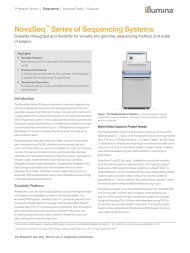Abstracts
ngsfinalprogram
ngsfinalprogram
You also want an ePaper? Increase the reach of your titles
YUMPU automatically turns print PDFs into web optimized ePapers that Google loves.
Poster <strong>Abstracts</strong><br />
cost reduction of next generation sequencing<br />
has allowed researchers to migrate from<br />
analyzing distinct loci in only few prototypical<br />
isolates to whole genome sequencing typing<br />
(WGST) of large bacterial collections. The<br />
growing sequence databases fortified with<br />
strain-associated metadata require efficient<br />
and well-integrated bioinformatics tools that<br />
will explore and harvest the information<br />
content of WGS data to enhance the traceability<br />
of microbes in support of informed and<br />
timely countermeasures. Particularly single<br />
nucleotide polymorphism (SNP) discovery<br />
and typing often surpass labor-intensive molecular<br />
typing schemes in offering both robust<br />
long- and short-term high-resolution variant<br />
markers. Methods: Our group has developed<br />
a bioinformatics SNP Discovery and Validation<br />
Pipeline (SNPDV) implemented on the<br />
open source platform Galaxy coded in Python<br />
that makes use of the wealth of sequence data<br />
for the whole genome sequence typing of<br />
bacterial pathogens. Its modular architecture<br />
guarantees high flexibility and scalability for<br />
SNP discovery and validation and can be run<br />
in serial, multiprocessor, or threaded version<br />
depending on available server capabilities.<br />
This pipeline allows to rapidly type strains of<br />
unknown provenance by testing allelic states<br />
in already established SNPs panels, or for unbiased<br />
de novo discovery. Results: Given the<br />
clonal nature of outbreaks, we have successfully<br />
deployed this pipeline in the investigation<br />
of the 2010 Haiti cholera and 2006 spinach<br />
outbreaks, and diverse other enteric and<br />
emerging pathogens, such as Yersinia pestis,<br />
Bacillus spp., Vibrio spp., and Acinetobacter<br />
baumannii, achieving improved phylogenetic<br />
accuracy and resolution. Discussion: Following<br />
the concept of genomic epidemiology<br />
the gathered phylogenomic data have major<br />
public health relevance in utilizing sequencebased<br />
information for improved surveillance,<br />
strain attribution, and source identification<br />
to contain outbreaks. Canonical SNPs can be<br />
implemented in efficient typing assays offering<br />
robust phylogenetic signals for outbreak inand<br />
exclusion that surpass classical technologies.<br />
The phylogenomic framework is a further<br />
critical resource to precisely cluster pathogens<br />
into subgroups distinguished by different genotypic,<br />
epidemiological, and phenotypic traits,<br />
such as whether particular genotypes reflect<br />
highly pathogenic subpopulations. Future<br />
developments are directed towards the cloud<br />
implementation of this pipeline in collaboration<br />
with the UTSA Cloud and Big Data Laboratory<br />
(NSF Cloud).<br />
n 12<br />
COMBINING LABORATORY AND<br />
EPIDEMIOLOGICAL DATA FOR OUTBREAK<br />
INVESTIGATION AND PUBLIC HEALTH<br />
SURVEILLANCE: LESSONS FROM AN<br />
OUTBREAK OF HIV-1 INFECTION LINKED TO<br />
INJECTION DRUG USE OF OXYMORPHONE _<br />
INDIANA, 2015<br />
E. M. Campbell 1 , R. R. Galang 1 , J. Gentry 2 , P.<br />
J. Peters 1 , S. J. Blosser 2 , E. L. Chapman 2 , C.<br />
Conrad 2 , J. W. Duwve 2 , L. Ganova-Raeva 3 , W.<br />
Heneine 1 , D. Hillman 2 , H. Jia 1 , L. Lui 2 , J. Lovchik<br />
2 , A. Perez 2 , P. Peyrani 4 , P. Pontones 2 , S.<br />
Ramachandran 3 , J. C. Roseberry 2 , M. Sandoval<br />
2 , A. Shankar 1 , H. Thai 3 , G. Xia 3 , Y. Khudyakov<br />
3 , W. H. Switzer 1 ;<br />
1<br />
Division of HIV/AIDS Prevention, National<br />
Center for HIV/AIDS, Viral Hepatitis, STD,<br />
and TB Prevention, CDC, Atlanta, GA, 2 Indiana<br />
State Department of Health, Indianapolis,<br />
IN, 3 Division of Viral Hepatitis, National Center<br />
for HIV/AIDS, Viral Hepatitis, STD, and<br />
TB Prevention, CDC, Atlanta, GA, 4 Division of<br />
Infectious Diseases, University of Louisville,<br />
Louisville, KY.<br />
In January 2015, a cluster of HIV-1 infections<br />
was detected in rural Indiana among persons<br />
who reported injecting the prescription opioid,<br />
oxymorphone. As of May, HIV-1 infection<br />
was diagnosed in 153 individuals. Molecular<br />
analyses of HIV-1 and HCV sequences were<br />
combined with epidemiological data via a<br />
novel bioinformatics pipeline to infer the<br />
timing of HIV transmission relative to HCV<br />
and to explore risk factors associated with<br />
46<br />
ASM Conferences



